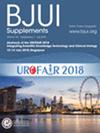使用或不使用恩杂鲁胺的ENACT试验患者前列腺肿瘤的转录组分析
IF 4.4
2区 医学
Q1 UROLOGY & NEPHROLOGY
引用次数: 0
摘要
目的评估ENACT试验(ClinicalTrials.gov识别码:NCT02799745)患者随时间发生的纵向转录组变化。ENACT评估了低风险或中风险前列腺癌患者,比较了恩杂鲁胺加主动监测(AS)与单独应用AS的疗效和安全性。患者和方法使用Decipher Genomic Resource for Intelligent Discovery (GRID)平台(Veracyte, Inc.)对131例患者样本(enzalutamide + AS: n = 57;单独AS: n = 74)在筛查、第1年和第2年收集。预先定义的GRID特征被分析与生物学和临床特征的关联,包括免疫活性、治疗敏感性、转移风险和分子亚型。统计分析使用Cox比例风险模型和logistic/线性回归,而纵向变化评估使用线性混合效应模型。结果在治疗的第1年,恩杂鲁胺加AS的患者表现出显著的转录组变化,如雄激素受体信号和免疫抑制信号下调,同时免疫激活和基础样标志物上调。许多这些转录组改变,包括免疫相关的改变,是短暂的,在恩扎鲁胺治疗停止后的第2年恢复到基线水平。这项探索性生物标志物分析突出了AS患者和接受enzalutamide治疗的患者的转录组变化,为监测分子疾病进展和短暂暴露于enzalutamide的影响提供了见解。在恩杂鲁胺治疗期间观察到的免疫调节提示了探索免疫治疗策略的机会。本文章由计算机程序翻译,如有差异,请以英文原文为准。
Transcriptome profiling of prostatic tumours from ENACT trial patients with or without enzalutamide
ObjectivesTo evaluate the longitudinal transcriptomic changes that occurred over time in patients from the ENACT trial (ClinicalTrials.gov identifier: NCT02799745). ENACT evaluated patients with low‐ or intermediate‐risk prostate cancer, comparing the efficacy and safety of enzalutamide plus active surveillance (AS) to AS alone.Patients and MethodsGene‐expression profiling was conducted using the Decipher Genomic Resource for Intelligent Discovery (GRID) platform (Veracyte, Inc.) on 131 patient samples (enzalutamide plus AS: n = 57; AS alone: n = 74) collected at screening, Year 1, and Year 2. Pre‐defined GRID signatures were analysed for associations with biological and clinical features, including immune activity, treatment sensitivity, metastatic risk, and molecular subtypes. Statistical analyses utilised Cox proportional hazards models and logistic/linear regression, while longitudinal changes were evaluated using linear mixed‐effects models.ResultsAt Year 1, patients treated with enzalutamide plus AS showed significant transcriptomic changes, such as downregulation of androgen‐receptor signalling and immune‐suppressor signatures, alongside upregulation of immune‐activated and basal‐like markers. Many of these transcriptomic alterations, including immune‐related changes, were transient and reverted to baseline levels at Year 2 after enzalutamide treatment cessation.ConclusionThis exploratory biomarker analysis highlights transcriptomic changes in patients undergoing AS and those treated with enzalutamide, providing insights into molecular disease progression on surveillance and the effects of transient exposure to enzalutamide. The observed immune modulation during enzalutamide treatment suggests opportunities to explore immunotherapy strategies.
求助全文
通过发布文献求助,成功后即可免费获取论文全文。
去求助
来源期刊

BJU International
医学-泌尿学与肾脏学
CiteScore
9.10
自引率
4.40%
发文量
262
审稿时长
1 months
期刊介绍:
BJUI is one of the most highly respected medical journals in the world, with a truly international range of published papers and appeal. Every issue gives invaluable practical information in the form of original articles, reviews, comments, surgical education articles, and translational science articles in the field of urology. BJUI employs topical sections, and is in full colour, making it easier to browse or search for something specific.
 求助内容:
求助内容: 应助结果提醒方式:
应助结果提醒方式:


